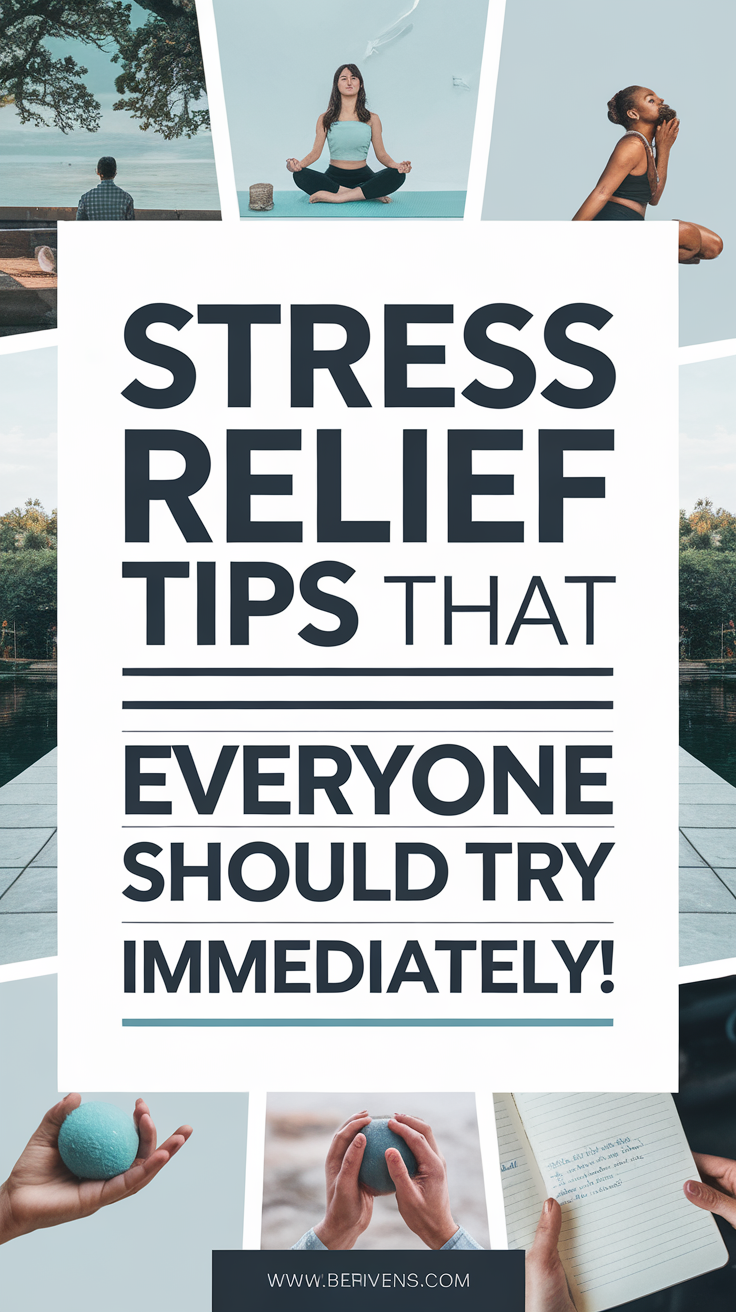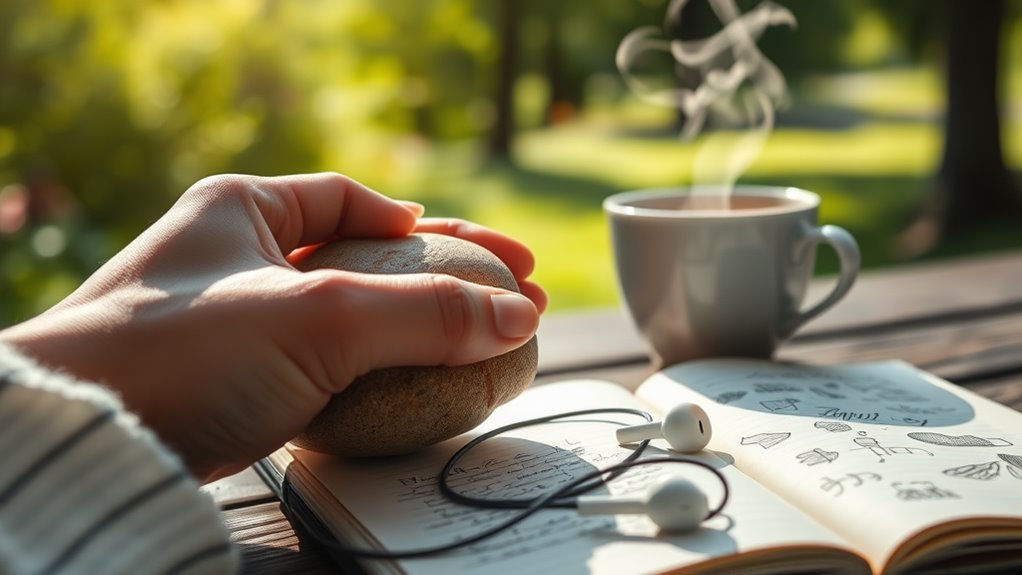Stress Relief Tips That Everyone Should Try Immediately!
You can relieve stress today by incorporating simple strategies into your daily routine. Start with deep breathing techniques, like the 4-7-8 method, to calm your mind. Engage in physical activity, even a short walk outdoors can boost your mood. Mindfulness practices, such as meditation, help you stay present and reduce anxiety. Creative outlets, like journaling or drawing, allow for emotional expression. Strengthening social connections can also provide essential support. Finally, focus on healthy eating to fuel your body and mind. There’s so much more you can explore to enhance your well-being and effectively manage stress.
Key Takeaways
- Practice deep breathing techniques like the 4-7-8 method to quickly calm your nervous system and reduce stress.
- Engage in physical activity, as even a short walk can release endorphins and improve your mood.
- Take a mindful nature walk to immerse yourself in the calming effects of the outdoors and lower anxiety levels.
- Incorporate expressive writing to release pent-up emotions and gain clarity in your thoughts without the pressure of perfection.
- Connect with friends or family for social support, as strong relationships can significantly enhance your resilience to stress.
Deep Breathing Techniques
When life’s pressures start to weigh you down, deep breathing techniques can be your best ally for stress relief. These simple yet powerful breathing exercises can help you regain control and bring a sense of calm to your chaotic mind. By focusing on your breath, you shift your attention away from stressors, allowing your body to relax and your mind to clear.
One effective method is the 4-7-8 technique. Inhale deeply through your nose for four seconds, hold your breath for seven seconds, and then exhale slowly through your mouth for eight seconds. This practice not only calms your nervous system but also enhances your lung capacity.
Another approach is diaphragmatic breathing, where you engage your diaphragm, allowing for fuller, deeper breaths.
Incorporating these relaxation techniques into your daily routine can create a powerful habit that promotes emotional resilience. You can practice them anywhere—whether at your desk or in a quiet corner of your home.
Physical Activity Benefits
When you’re feeling stressed, getting active can be a game changer.
Just a little physical activity can boost your mood, reduce anxiety, and even help you sleep better at night.
Boosts Mood Instantly
Physical activity’s incredible ability to boost your mood can feel like a revitalizing change on a tough day. Engaging in mood-boosting activities, whether it’s a brisk walk, dancing, or playing a sport, releases endorphins—your brain’s natural feel-good chemicals. These activities not only elevate your spirit but also foster a sense of accomplishment, which can be immensely satisfying.
Incorporating laughter therapy into your routine can further amplify these benefits. Share a funny video with a friend or attend a comedy show; laughter works wonders for your emotional state.
Combine physical activity with laughter, and you’ve got a powerful recipe for instant mood enhancement. When you embrace these practices, you’re not just moving your body; you’re actively cultivating a more positive mindset.
Reduces Anxiety Levels
One of the most effective ways to reduce anxiety levels is through regular physical activity. When you engage in exercise, your body releases endorphins, which are natural mood lifters. This can help counteract the anxiety triggers that often weigh you down. You might find that even a short walk or a quick workout can create a significant shift in how you feel.
Incorporating physical activity into your routine is an essential part of anxiety management. It provides a constructive outlet for stress and helps you build resilience against future challenges. As you become more physically active, you’ll likely notice an improvement in your ability to cope with anxiety, leading to a more balanced emotional state.
Don’t underestimate the power of movement. Whether you prefer running, dancing, or yoga, find what resonates with you. The key is consistency; aim for a schedule that feels manageable yet challenging.
Improves Sleep Quality
Regular exercise not only helps in managing anxiety but also plays a significant role in improving sleep quality. When you engage in physical activity, your body releases endorphins, which can help regulate your mood and promote a sense of well-being, making it easier to drift off at night.
Establishing a consistent exercise routine can also enhance your sleep hygiene. To maximize the benefits of exercise for better sleep, consider incorporating it into your bedtime routine. Aim for at least 30 minutes of moderate activity most days, but try to avoid vigorous exercise right before bed, as it might energize you instead of relaxing you. Finding the right balance is key.
Additionally, create a calming atmosphere in your bedroom. Dim the lights, keep the temperature cool, and minimize distractions to signal to your body that it’s time to wind down.
Mindfulness and Meditation
Finding tranquility in the chaos of daily life can feel like an elusive dream, but mindfulness and meditation offer a path to serenity. By cultivating mindful awareness, you can ground yourself in the present moment, reducing stress and enhancing overall well-being. These practices don’t require hours; even a few minutes can make a difference.
Consider incorporating the following meditation practices into your routine:
-
Breath Awareness: Focus on your breath, noticing each inhale and exhale. This simple act can anchor you and calm your mind.
-
Body Scan: Slowly bring your attention to each part of your body, releasing tension as you go. This fosters a deeper connection with yourself.
-
Guided Meditation: Use apps or online resources to follow guided sessions. These can provide structure and support as you explore mindfulness.
Embracing these techniques can transform your experience, helping you navigate stress with greater ease.
Nature Exposure
Stepping outside into nature can be a powerful antidote to stress. When you immerse yourself in the great outdoors, you’re not just getting fresh air; you’re engaging in a practice that can greatly improve your mental well-being.
Nature walks, for instance, allow you to disconnect from daily pressures while promoting mindfulness. As you walk, pay attention to the sounds, sights, and scents around you. This simple act can ground you, helping to clear your mind.
Another technique to take into account is forest bathing, a Japanese practice known as Shinrin-yoku. This approach encourages you to take in the forest atmosphere through all your senses.
Feel the texture of tree bark, listen to rustling leaves, and breathe in the earthy scents. Studies have shown that spending time in nature can lower cortisol levels, reduce anxiety, and enhance overall happiness.
Creative Outlets
Finding creative outlets can be a powerful way to relieve stress and express your feelings.
Whether it’s picking up a paintbrush or putting pen to paper, these activities can serve as a therapeutic release, helping you process emotions and clear your mind.
Embrace your creativity—it’s a valuable tool for your mental well-being.
Art as Therapy
Engaging in art can be a transformative experience, offering a powerful outlet for stress relief and emotional expression. Art therapy isn’t just for professionals; it’s a practice anyone can embrace.
Whether you’re painting, drawing, or sculpting, tapping into your creative expression can help you navigate life’s challenges with greater ease.
Here are three ways art can guide you towards emotional well-being:
-
Visual Journaling: Create a space where you can express your thoughts and feelings visually. Use colors and shapes to represent your emotions, allowing you to process them without words.
-
Mindful Creation: Focus on the process rather than the outcome. Immerse yourself in the act of creating, which can help ground you and reduce anxiety.
-
Community Engagement: Join a local art class or online group. Sharing your work and collaborating with others can foster connections and provide a support system during stressful times.
Writing for Release
Creative expression takes many forms, and writing can be an incredibly powerful tool for stress relief. When you engage in expressive writing, you’re not just putting words on a page; you’re tapping into your emotions and processing your experiences. This technique helps to clarify your thoughts and feelings, enabling you to confront stressors head-on.
One of the greatest journaling benefits is its ability to provide a safe space for reflection. You can pour out your thoughts without judgment, allowing you to gain insights into what’s truly bothering you.
Whether it’s through daily journaling or spontaneous poetry, the act of writing helps to release pent-up emotions and fosters a sense of control.
The beauty of expressive writing lies in its versatility—it can be structured or free-form, allowing you to explore different styles.
Don’t worry about grammar or punctuation; let your creativity flow. Remember, the goal isn’t to create a masterpiece, but to find relief and understanding.
Social Connections
Human connections are essential for your well-being, especially when it comes to managing stress. Engaging with others can help you build resilience and foster a sense of belonging.
Here are three effective ways to enhance your social connections:
- Friendship Building: Make an effort to nurture existing friendships or form new ones. Schedule regular catch-ups, whether it’s a coffee date or a virtual hangout.
These connections provide emotional support you can lean on during tough times.
- Community Engagement: Get involved in local activities or volunteer opportunities. Engaging with your community not only builds social networks but also enhances your sense of purpose.
You’ll find fulfillment in helping others while creating lasting bonds.
- Open Up: Don’t hesitate to share your thoughts and feelings with trusted friends or family.
Vulnerability fosters deeper connections, and they may offer insights or support you hadn’t considered.
Healthy Eating Choices
Making healthy eating choices isn’t just about following a strict diet; it’s about nurturing your body with the right nutrients to manage stress effectively. When you fuel your body with wholesome foods, you’re not only enhancing your physical health but also improving your mental well-being.
Start with meal planning. By preparing your meals in advance, you can guarantee you’re always opting for nutrient-rich ingredients instead of reaching for unhealthy snacks when you’re stressed. Think colorful fruits, leafy greens, and lean proteins that provide lasting energy.
Portion control is equally essential. It’s easy to overeat when you’re feeling overwhelmed, but by being mindful of your serving sizes, you can prevent that sluggish feeling that often accompanies stress.
Using smaller plates can help, as can pre-portioning your meals.
Frequently Asked Questions
How Long Should I Practice Deep Breathing Each Day?
To master deep breathing techniques, aim for at least 5 to 10 minutes daily. Consistency is key; even short sessions can considerably enhance your relaxation and mindfulness over time. You’ve got this!
What Type of Physical Activity Is Best for Stress Relief?
Think of physical activity as a balm for your soul. Yoga benefits your mind and body, while dancing brings joy that’s hard to beat. Try both; you’ll find stress relief in movement that feels effortless.
Can Mindfulness Help With Anxiety and Depression?
Absolutely, mindfulness techniques can greatly aid in anxiety management. By practicing mindfulness, you’re training your mind to focus, reducing negative thoughts, and fostering a sense of calm, which can empower you to better handle anxiety and depression.
How Can I Incorporate Nature Exposure Into My Routine?
Incorporating nature exposure into your routine can be transformative. Consider taking regular nature walks or practicing outdoor meditation. These simple activities can ground you, offering peace and clarity while enhancing your overall well-being. You’ve got this!
What Are Some Easy Creative Outlets for Beginners?
If you’re looking to dabble in something delightful, why not try art journaling or DIY crafts? They’re perfect for releasing your creativity while providing a gentle escape, helping you discover your artistic side without pressure.





